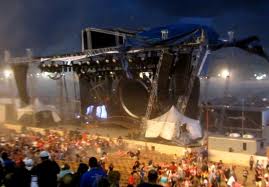Eventsindustryforum.co.uk (2011) describes temporary demountable structures (TDS) as a design which is rapidly erected and dismantled many times for a short term basis. Temporary Structures – For Business, Leisure & Emergency Use (2011) highlights that TDS are crucial to event organisers as they are proven to be versatile, cheap and quicker to build than regular structures which make them ideal for festivals. However they fail to mention another reason which makes TDS useful for events is that they do not require a premise licence. Though they do need to obtain a TEN (temporary event notice) but this is only relevant with events dealing with less than 500 people.
Sounds good doesn’t it? However there are implications when using TDS’s as de Brito & Pimentel (2009) acknowledge the main contributor for stage collapsing is overloading. The Health and Safety Executives (HSE) agree with this but also identify that poor construction can be a determining factor. However the HSE respond to this by advising that all event managers should get the contractors to sign off on a structure. This will ensure that the construction is double checked and if anything was to go wrong that liability would fall into the laps of the organisation constructing the project.
When I visited Benicassim festival a few years ago, we were troubled by strong winds which resulted in TDS’s throughout the festival becoming potential risks. Thankfully there was a strong evacuation plan in place to ensure nobody was injured.
However, as can be seen in the picture taken in 2011 at the Indiana State Fair, things do go wrong! This was a result from strong winds, lack of assertiveness from the event organiser and an ill constructed evacuation plan. As a result the state introduced a new piece of legislation mainly illustrating the importance of an evacuation plan which is supported by In.gov (2011).
Istructe (2007) highlights other issues which concern TDS. It mentions potential hazards which should be considered, such as crowd control, construction and dismantling. These issues can be combatted via respected contractors and comprehensive security team.
Overall, TDS’s are instrumental for event organisers mainly due to their versatility and cheap nature. However, as has been established there are a lot of potential risks concerning these structures and at the end of the day the buck falls at the feet of the event organiser. For this reason it is important to get reliable contractors who can sign off on the structure. Also being prepared against adverse weather conditions is vital as is shown at the Indiana State Fair.
de Brito, V. L., & Pimentel, R. L. (2009). Cases of Collapse of Demountable Grandstands. Journal of Performance of Constructed Facilities, 23(3), 151-159.
Eventsindustryforum.co.uk (2011) The Event Industry Forum. [online] Available at: http://www.eventsindustryforum.co.uk/ [Accessed: 14 Dec 2012].
In.gov (2011) IDHS: Fire Prevention and Building Safety Commission Code Review Committees Information. [online] Available at: http://www.in.gov/dhs/2494.htm [Accessed: 14 Dec 2012].
Istructe (2007) Temporary demountable structures Guidance on procurement, design and use. [e-book] London: The Institution of Structural Engineers. Available through: http://www.bigtopmania.co.uk http://www.bigtopmania.co.uk/pdf_downloads/Marquee_industry_guidance/Temporary_Structures_3rd_ed_2007_Guidance_ISE.pdf [Accessed: 14/12/2012].
Temporary Structures – For Business, Leisure & Emergency Use (2011) Temporary Structures – Features & Benefits. [online] Available at: http://temporarystructures.weebly.com/temporary-structures—features–benefits.html [Accessed: 14 Dec 2012].
